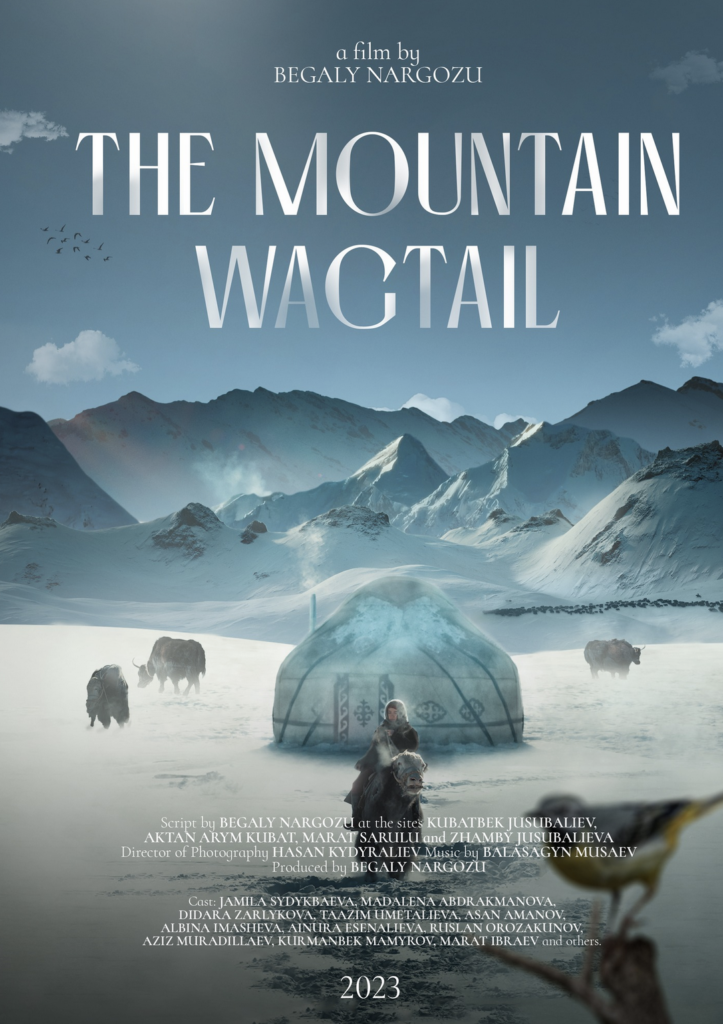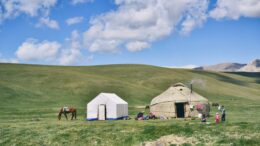Every winter young Altyn, the protagonist of Kyrgyzstani director Begaly Nargozu’s 2023 film The Mountain Wagtail, would mount her horse, leave her village in the valley, and head to the syrt, an unchanging landscape of snow and glaciers stretching across the mountaintops of Kyrgyzstan, to help her nomadic grandparents herd their yaks. Altyn’s innocent, kind-hearted nature — nurtured by the beauty of the icy landscape and her grandparents’ reverence for it — is tested when, in the twilight of her teenage years, she moves to the capital of Bishkek to attend university. Staying with her older sister, a fully urbanized entrepreneur with a disdain for all things rural, Altyn soon finds herself confronted by all the trappings and evils of modern-day society, from alcoholism and sexual assault to domestic violence and environmental pollution.
The Mountain Wagtail premiered in 2023 and has recently played at ecology-themed Sprouts Film Festival in Amsterdam and other film festivals across Europe and Asia.
Nargozu says his village, like Altyn’s unnamed hometown, is surrounded by “holy mountains which hundreds of people visit every day to pray and ask for a better life.” His tale of Altyn’s journey to the city echoes the journeys of many young Kyrgyzstani women as heavy industry, mining operations, and high unemployment rates turn the countryside increasingly inhospitable.
“Tons of dust rise into the air each day from mining development and settle on the surrounding glaciers,” he tells The Revelator. “Millions of cubes of ice are melted, billions of tons of harmful substances are poured into rivers. Every year, there are fewer pastures and grasslands. The traditional pastoral life of the highlands is being destroyed, and so people leave the mountains and go to the cities, where living conditions are poorer still.”
In addition to a lack of affordable housing, unauthorized construction, and poor waste management, Bishkek’s air quality is among the worst in the world, resulting in roughly 4,000 premature deaths each year. Contributing factors range from factory and vehicle emissions to the country’s continued and widespread use of coal. Sharing the blame is Bishkek’s landfill, originally dug by the Soviet Union, which was too small to keep up with the city’s growing population and, as a result, regularly caught fire and filled the air with toxic fumes. (After years of struggling to procure international investment and circumvent government corruption, a new landfill opened in 2023.)
Historically, says Nargozu, “the Kyrgyz did not treat the mountains as consumers; they did not look for valuable materials there, blowing up anything and everything. On the contrary, they worshiped and prayed to them, living for thousands of years without major problems with nature, in harmony.” According to Nargozu, it was only with the advent of the colonization of imperial Russia that the extraction of valuable metals and toxic substances from the Kyrgyz mountains on an industrial scale began.

The distinction at the center of The Mountain Wagtail isn’t between urban and rural but syrt and non-syrt. Altyn’s village, though isolated, pastoral, and idyllic by western standards, is presented as a kind of Bishkek writ small: a sign of the future that awaits the Kyrgyzstani countryside. Only the syrt remains free of the spiritual corruption radiating from Bishkek. Up there, accompanied only by snow, sun, yaks, and an ecologist researching the melting glaciers, Altyn’s grandparents live in unceasing peace and happiness. The only couple in the film that treats one another with kindness and respect, Nargozu’s screenplay refers to them as “celestial beings.” But they are also an endangered species.
The Mountain Wagtail’s mixed reception inside Kyrgyzstan reflects the hold heavy industry has on the country and its culture. When Nargozu showed the film at the Ala-Too cinema in the capital in 2023, he says it was warmly received by creatives and the intelligentsia. Government officials were less enthusiastic, though. When the film began receiving awards from international festivals, Nargozu said they asked him: “Why spread negativity about Kyrgyzstan throughout the world? We need to be more patriotic and show only our good side.”
“It looks depressing,” Nargozu says of Kyrgyzstan’s future. “Every year we export tons and tons of pure gold, yet we remain among the poorest countries of the world. Should we continue to mine gold if — instead of happiness — it only brings us closer to environmental disaster?”
In search of answers, he looks to the same place Altyn does when she feels lost — the syrt:
“Maybe we need to live like our ancestors, protecting nature and the traditional, pastoral way of life of the mountaineers.” In The Mountain Wagtail, he uses the color white to symbolize the natural purity of the Mongu-Ata glacier as well as Altyn’s moral purity.
“Just as rivers originate from mountain lakes and glaciers, so Altyn’s spiritual purity begins with her grandfather and grandmother. She is their spiritual heir,” Nargozu says. “The film begins with the snow-capped syrt and white-topped mountain peaks and ends at the Mongu-Ata glacier and the sacred silver lake Kumush-Kol. Such is the fate of Altyn, who descends from the snow-white mountains and, having gone through a series of trials in the city, returns to her own roots, to the traditional way of life and fundamental values of her people.”
Watch the trailer to Mountain Wagtail below:
Trailer: The Mountain Wagtail | SproutsFF24 from Sprouts Film Festival on Vimeo.

Previously in The Revelator:
The Story of Plastic: New Film Exposes the Source of Our Plastic Crisis


